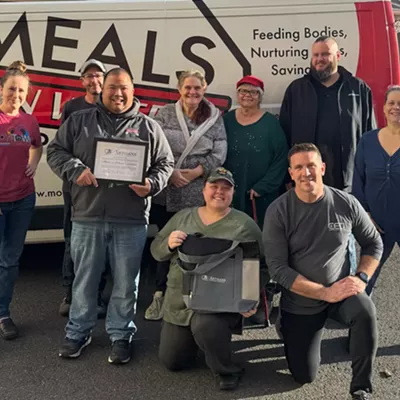While walking through seemingly boundless forests, grassy groves and rocky hills, you may see a squirrel leaping overhead or a moose grazing through Dishman Hills, a conservation area stretching over 3,000 acres.
Dishman Hills Conservancy, formed in 1966, is the oldest land conservancy organization in the state of Washington.
As part of their mission, the conservancy aims to protect the area and connect the community to the land through conservation, education and stewardship.
With six main trailheads, the area provides people with a variety of hiking opportunities to see the region's unique wildlife, geology and plant species.
Dishman Hills Conservancy's executive director Ruth Gifford says that as Spokane and other surrounding areas expand, the importance of protecting land for other species increases.
"It is really a critical habitat for wildlife in their ability to move around and get enough resources to survive in the area," she says.
Rather than distinguishing who owns which acres, the land's owners — the Dishman Hills Conservancy, the Washington Department of Resources and Spokane County — collaborate.
"This is a jointly managed area," Gifford says. "That's kind of a unique thing in the state for an organization, a nonprofit, to partner with those government agencies."
Many types of volunteer efforts help the Conservancy with its mission to "connect and protect" the Dishman Hills.
Hikes and nature walks for groups of up to 25 people are led by volunteers with expertise to point out the area's flora, fauna and geology. The organization's Volunteer Stewards program offers training for stewards who assist the public with trail use and monitor trail conditions. Volunteers are also needed for field work such as planting trees, maintaining trails and installing signage. And volunteers are encouraged to contribute photography and writing to the Conservancy newsletter and blog.
Financial donations assist with land stewardship and educational programs. Become a Conservancy member for $35 annually and receive priority registration for hikes and nature walks.
The Conservancy's newly-acquired 120 acre Wilson Creek Conservation area, accessed at 6712 E. Willow Springs Road, is now open and Executive Director Ruth Gifford will lead hikes there each month on the second fourth Tuesdays as long as roads are clear. For more information on events and volunteering go to dishmanhills.org
MORE TO CHECK OUT
Friends Of The Centennial Trail
Friends@SpokaneCentennialTrail.org
For almost 30 years, the Friends of the Centennial Trail have been advocating for maintenance, safety and completion of the trail.
Spanning 40 miles from the Washington-Idaho state line to Nine Mile Falls, the Centennial State Park Trail is the backbone of Eastern Washington's recreation trails, according to Executive Director Loreen McFaul.
The Friends of the Centennial Trail also watches over adjacent trails that spur off from the Centennial Trail, as well as neighboring parklands.
Every year, the nonprofit organizes an Earth Day cleanup event where groups clean up trash from a designated section of the trail. You can also support the Friends of the Centennial Trail by donating or becoming a member at spokanecentennialtrail.org.
Spokane Riverkeeper
35 W. Main Ave., Suite 308
Water is vital to all life, so protecting and advocating for landmark rivers like the Spokane River is important to the community and region's ecosystems.
The Spokane Riverkeeper leverages laws to protect the river, leads litter pickup programs, and studies the science of how to navigate challenges associated with low summer flows and restoration of fish habitats.
"We're really trying to get waste water cleaned up and out of our river," says Jerry White, Spokane Riverkeeper's executive director.
To find information on future events and volunteer opportunities, or to make a donation, visit spokaneriverkeeper.org.
Palouse-Clearwater Environmental Institute
1040 Rodeo Dr., Moscow
Located downwind of the Hanford nuclear power plant, community members in the Palouse formed the Palouse-Clearwater Environmental Institute in 1986 following the Chernobyl nuclear reactor explosion as a way to restore and protect the region's natural resources.
The institute offers a variety of volunteer opportunities, such as educating people on local issues, restoring creek beds and watersheds, community service, and modeling sustainable living at their numerous nature centers.
Additionally, the group started the Plate Project, an inexpensive way for people to reserve dishes, glasses and utensils for their events. All of the pieces in their collection have been donated or acquired from thrift stores and garage sales.
More information about the institute and upcoming volunteer opportunities can be found at pcei.org.
























